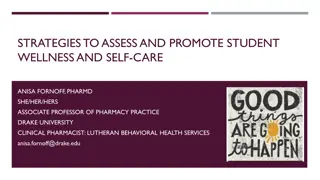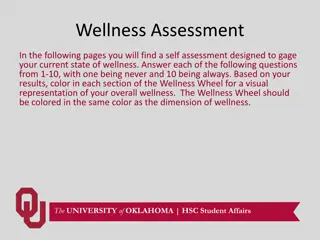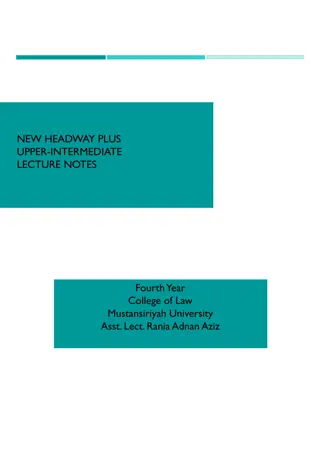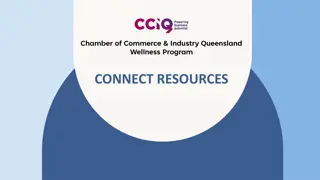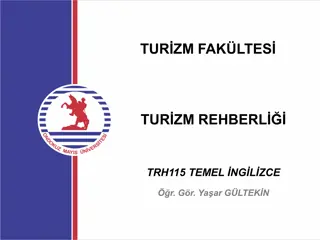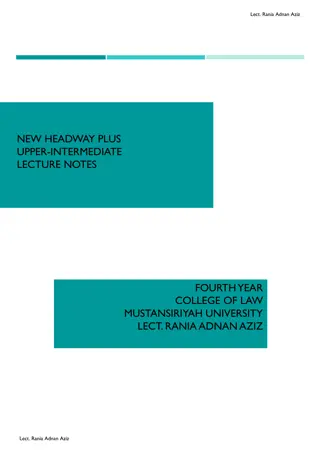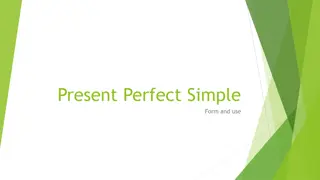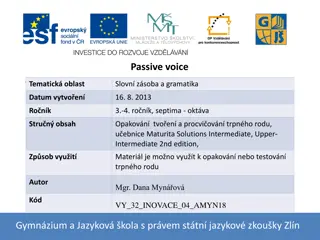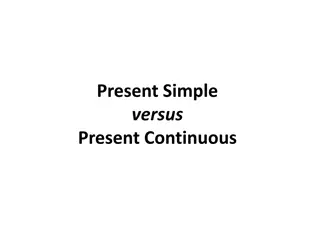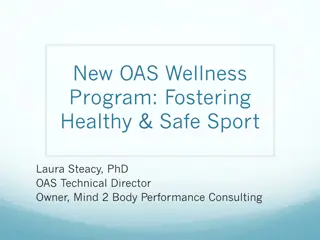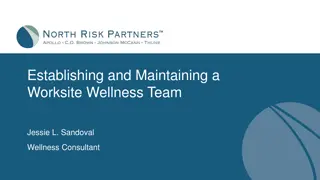Evolution of Worksite Wellness Programs: Past, Present, and Future
The evolution of worksite wellness programs from the 1970s to the present day is highlighted, showcasing the shift from fitness-focused initiatives to holistic approaches addressing health, productivity, and sustainability. The growing costs of illnesses such as diabetes are discussed, along with the determinants of health, risk factors, and prevention strategies. The impact of direct and indirect costs on businesses is explored, emphasizing the importance of promoting a healthy workforce for increased productivity and reduced health risks.
Download Presentation

Please find below an Image/Link to download the presentation.
The content on the website is provided AS IS for your information and personal use only. It may not be sold, licensed, or shared on other websites without obtaining consent from the author. Download presentation by click this link. If you encounter any issues during the download, it is possible that the publisher has removed the file from their server.
E N D
Presentation Transcript
Worksite Wellness Programs Past, Present and Future
The evolution of worksite wellness programs 1970s - focus on fitness 1980s - risk reduction Early 1990s - health and productivity management Later 1990s - population management 2000s- total worker program Today Business sustainability Activity centered Results oriented
The growing cost of illness Did you know? 100 plus million Americans have been diagnose with pre or type 2 diabetes A major consequence of type 2 diabetes will be cardiovascular diseases Up to 65% of Americans currently do not have their conventional risk biomarkers under control 7 in 10 Americans take at least one prescription drug daily; one-half take two; 20% take five.
Determinants of Health Lifestyle and Chronic Conditions 50% of premature deaths in the US are related to modifiable lifestyle factors. Unhealthy lifestyle leads to chronic disease 800,000 + deaths/yr. Chronic disease related to lifestyle account for 70% of the nations medical costs. Health Behaviors Environment Genetics Access to Care
Risk factors & prevention According to the U.S. Department of Health and Human Services: 59% of employees do not get adequate exercise 50% or more have high cholesterol 27% have cardiovascular disease 26% are overweight by 20 percent or more 24% have high blood pressure Between 70 to 90 percent of health care spending is caused by preventable, modifiable health risks such as the ones bulleted above.
Direct versus indirect costs Direct or visible Costs at the tip of the iceberg Indirect or invisible costs below the surface Presenteeism Short and long-term disability Absenteeism Work Comp These costs = 2-3x direct medical costs Medical Pharmaceutical You can t ignore the direct costs but at the same time, you cannot deny the costs that are harder to see.
The good news A healthy workforce is a more productive workforce: Reducing just 1 health risk factor (i.e. obesity, smoking, high blood pressure) increases a person s productivity by 9% reduces absenteeism by 2%. Keep the healthy people healthy 60% of workforce = low-risk (less than 2 risk factors) 30% =medium-risk 10% = high-risk 80% of costs come from the high risk numbers Did you know? $350 is saved when a low-risk employee stays low-risk. When you target the high-risk population only $153 is saved when risks are reduced.
Current Trends - Whats not working? Extrinsic rewards Large online platforms Program design based on risk factors only Doing the same thing every year Lack of diversity and breath of outreach A recent Gallup study highlighted these statistics: The bulk of employees worldwide -- 63% -- are "not engaged," meaning they lack motivation and are less likely to invest discretionary effort in organizational goals or outcomes. And 24% are "actively disengaged," indicating they are unhappy and unproductive at work and liable to spread negativity to coworkers. In rough numbers, this translates into 900 million not engaged and 340 million actively disengaged workers around the globe.
Current Trends - Whats working? Reframing the people, place and purpose of wellness programs Broader communities Building relationships and collaborating Connecting work activities with the mission and purpose of the organization Including leadership involvement and visibility Communication is transparent Work/life balance Acknowledging the role employees play outside of the workplace Flexible work schedules and locations Well-being with a focus on mind, body and spirit Quality of life and how that can help employees be happier and more productive at work. Wellness is something we do with and for the people. It s not something we do to them.
Future wellness programs Wellness programs will be part of the culture, an accepted element of the business strategy. Wellness is not a single program, know what leadership cares about and measure broadly - Tom Perry, President of Integrated Benefits Institute Programs will be valued by the consumer (employees) so there is no need for incentives. Consumer driven programs Aligned with health care systems
Future wellness programs cont. Meaningful data will be created for stakeholders. You can t manage what you don t measure. Drill down to see the drivers of metrics helps to integrate data at the individual level across programs and time. - Paul Terry, Chief Health Officer of StayWell Technology is the modality, not the solution. Seth Serxner, Chief Health Officer, Senior Vice President of Population Health - Optum Care Solutions
Future wellness programs cont. Wellness opportunities will be leveraged outside of the workplace. Build support for employees with community programs Employers get involved in the community initiatives The focus will shift to the well-being of employees. Quality of life holistic approach Purpose and value of the program intrinsic motivation leads to behavior change.
Best practices Exceptional Programs have Exceptional Wellness Leaders who Dive into all layers - soliciting input, asking questions Create programs that are personal and engaging as well as intuitive and simple Experiment to see what resonates with the population Stay on top of innovation and new ideas Become change agents Leverage technology Model healthy behavior at work, home and in the community Wellness is not something you do for your population....it happens when work policies match employee values, with the right resources in place to make healthy choices easy.
Moving forward/ Recap Engage and impact Individuals Families Teams Organizations Communities Industry best practices CDC Worksite Health ScoreCard SHRM Foundation's Effective Practice Guidelines Series WELCOA - Well Workplace Awards American Heart Fit Friendly Companies U.S. Healthiest Workplace Accreditation Program
Moving forward continued Build a culture of health Leadership is visible and on board Policies and procedures promote wellness Benefits design supports wellness initiatives Environment encourages healthy choices and activities Ensure accessibility to everyone Utilize partnerships Consistent communications Incentives match the goals of the organization Programs reinforce participation in wellness as a shared expectation ASK your employees! Get out on the floors of the workplace and gather input
Worksite Wellness Service available to all North Risk Partners clients Employees are a company s most important asset. Let us help protect yours with complimentary worksite wellness services! Monthly WorkLife Wellness Newsletter Assistance with leveraging carrier options Employee interest surveys Training Special events (e.g. an NRP-sponsored health fair) Ongoing support from NRP s certified worksite wellness consultant Monthly WorkLife Wellness Newsletter- Designed to be easily shared by email or printed pdf, this employee-facing newsletter includes best practices for wellness at work and in life. Leveraging carrier options- Our worksite wellness expert will help you identify and leverage valuable wellness resources already built into your insurance plan. Employee interest surveys- We provide surveys to help you define the needs and interests of your employees, which in turn help you develop a more effective worksite wellness plan for your organization s unique culture Training- Attend expert-led trainings online or in person on a variety of different worksite wellness topics.
Ongoing support As is true with all of our services, the value of our worksite wellness services is rooted in our capacity to provide you with customized ongoing support from an industry expert. North Risk Partners worksite wellness consultant, Jessie Sandoval, is available to talk you through all phases of the worksite wellness planning and implementation process. About Jessie Certified Worksite Wellness Specialist (CWWS) and Program Manager (CWWPM) through the National Wellness Institute Certified Health Coach through the Institute for Integrative Nutrition Registered yoga instructor with over 11 years of teaching experience Contact Information Jessie L. Sandoval jessie@jswellnessllc.org 320.291.6285






